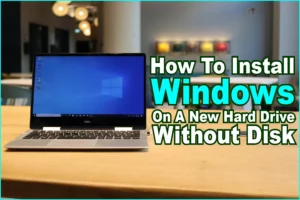
Computers revolutionized our world and changed how we go about everything. As we study more in the field, scientists add computers to new fields to make them safer for humans. The most crucial part of any computer system is the Operating System.
There are numerous operating systems on computers globally, including Linux and Ubuntu, but none have dominated the market like Windows.
Each update seems to have new and better features than the last, and you might want to try it, so here is an installation guide;
How To Install Windows On A New Hard Drive Without Disk
There are two ways to Install Windows, directly from a disk or by downloading the ISO file and installing it directly. If the drive is new, it means it doesn’t have an OS; thus, there is no way for you to download the ISO file.
Your only option is to find a disk since you can’t run an empty hard disk without an OS unless it is on connected external media.
Installing Windows Without External Media
You could want to install windows onto your computer, but you don’t have a flash drive or CD. The most common way of installing operating systems is to use a bootable external disk, making you think you can’t do it without the disk.
You will be happy to know that you can install Windows without a disk, and it will work the same as when you use a USB. Before we get started, remember that you will need at least 8GB of storage space for this to work. Let us get into the steps;
- The first thing you will need is the Windows ISO file for the version you want. In this process, we will use Windows 10, but the process for other versions is almost identical. Download the ISO file from the official Microsoft website.
Getting it from the official site will ensure you get a secure version without bugs or viruses. Search ‘download windows 10 ISO’ and click on the link with the Microsoft URL. You will get the link on the website to download the file; it might take a minute.
- Find the downloaded file in your downloads folder and run it. A pop-up will show you some terms and accept them after reading.
- In the next window, the PC will offer the option to create an installation media, select it and tap Next. The following window will allow you to choose the architecture and language you want to run on the system.
- The next page will have two choices, one for the USB drive and the other for the ISO file; select the ISO file and move on. A window will pop up for you to navigate to the location of the Windows 10 ISO file, and the download will start.
- After about 10 minutes, the download will complete, an icon will pop up on your home screen, and the file will be ready to use. The easiest way to install the file is to use a virtual drive and install Windows.
- You can use DAEMON tools to create the virtual drive, go to their official website, download the lite version, and launch it. Select a free license option on the first and second pages, then continue.
- Press next and run at the end of the installation, then close out the window.
- When you double-tap on the Windows ISO file, the system will define it as DVD Drive, open it and click set up to launch the Windows installation program. You only need to follow the screen prompts to go through the process.
In another window, you will get the option to install Windows and replace the original OS or alongside it based on what you need. You might end up losing all your files since the OS might clear your hard drive.
The computer will reboot several times as the system installs, and you will be ready to use it. You might need activation keys for Windows 10; for these, go to Ulaptop.com and buy the keys at a fair price.
You can also partition your hard drive and use one of the partitions, but you will have to partition your disk before you begin the installation. Create a partition of at least 5 GB, then copy the ISO image file onto that partition.
If you installed DAEMON tools, open the virtual drive and copy the files; if not, open the ISO file and extract its contents.
You will need to add some tools to make the system boot through the new drive, and it will be ready to use.
Risks Of Incorrect Windows Installation
You must have seen someone with a computer with two operating systems, for instance, Linux and Windows.
The installation of two Operating Systems on one computer is dual-booting, and it is standard on many PCs across the world.
Dual-booting offers you a lot of potential advantages if you use it correctly. Linux apps aren’t available for Windows and vice versa; dual-booting will allow you to access them on their independent platforms.
This way, you can take advantage of all the good features of the Operating systems and use them to compensate for each other’s failures.
This is advantageous, but it doesn’t come without risks, the first one being the potential for data loss.
Two Operating systems can’t run on the same drive, so you must partition your hard disk to dual boot your PC.
Partitioning can delete some of your files or wipe your drive clean, which means you will lose all your data, including the other Operating System.
You will risk accidentally erasing the other operating system or files in the partition as you install the system.
You can try recovery tools, but the chances of getting all your data back are minimal, and it can be frustrating if you have sensitive information.
Another issue with dual booting is that it compromises your system’s security, especially for those using Windows as one of the Operating systems. Hackers create viruses that can affect more users to collect more data or infiltrate systems.
Windows is widespread and has millions of users, so hackers target it more than other Operating Systems.
Linux isn’t as popular, so there are fewer viruses for it. Dual-booting will compromise your system by exposing your Linux partition to more viruses.
Reasons Why Windows Is Worth Using
The majority of the world runs Windows on their desktops, which implies some excellent features in the operating system.
macOS is popular, but Windows is still leading the OS market. Let us get into some of the reasons why Windows is a good Operating System;
- Gaming on windows is better. There are thousands of games for Windows, and it is easier to find them, update them and play them. Online marketplaces like Steam and Origin make this even easier, and gamers can take advantage of it.
Microsoft’s XBOX has recently integrated with more gaming companies to bring cross-platform play and purchases. Windows compatibility allows you access to a back catalog of games that has tens of thousands of titles to choose from.
- Support for peripherals for Windows. Windows is the most popular Operating system, and manufacturers of peripheral devices and software keep this in mind when they create their products.
All new graphic cars, RAMs, headsets, and so on are more polished to support the Windows platform than others. This means that you will get the best experience and fewer compatibility issues with Windows.
- It has a simple interface. Many people use computers for specific tasks, not out of curiosity. As such, they don’t want to know how the computer works, only that it finishes the work and that is what Windows offers.
To use an Operating System like Linux, you will need some intimate programming knowledge, which is challenging for most people. Windows has a simple GUI interface that makes it the best choice for beginners, and you can switch to a command-line interface.
- It is customizable. Many people don’t realize this, but you can change much more about your PC on Windows than the wallpaper and accent colors. You can change colors, fonts, icons, and most visual aspects.
You can also customize its functionality to meet the demands of your work more accurately. You can change core system functionalities with third-party tools, which will still work. This flexibility puts Windows miles ahead of other Operating Systems.
Conclusion
You need to have a disk or an external storage media to install Windows or any operating system on a blank hard drive. If the drive already has an OS and is running, you can download the ISO file for Windows and install it without a disk.
You can install an OS and use it to replace the old one or install it along with the old one in different partitions. Dual-booting will allow you to switch between the platforms quickly, but it poses several significant risks that make it something you should avoid.


